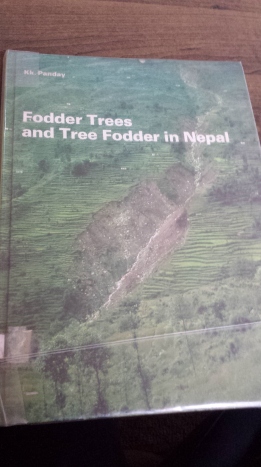Hello everyone! My name is Leslie Melnyk and I live in Kathmandu. This is my second winter reading session and my 4th session in general since summer 2015.
This time I’m choosing to use this winter reading challenge as an opportunity for continued education and I have no list–just going with the flow. I’m going to stick mostly to semi technical books and am going to make use of a library that has volumes from the 1980s. I love agricultural systems–particularly “old” or “outdated” ones that are now being reincorporated scientifically into sustainable ag. So, I’m going to try to find out more about livestock, cover crops, food storage methods, and intercropping specifics as they have traditionally existed in Nepal and other countries in Asia.
The first book on my non-list was published in 1981 and is about fodder trees in Nepal. I’m interested in fodder trees because their use seems like a great vertical use of space that can feed livestock from a small landplot. What I like most about this book is that it includes charts of flush and pruning times monthly by common fodder tree as well as nutrient content and the major warnings against feeding too much of one type of tree, also by tree. They break down the trees into weight by dry and wet biomass as well.
If anyone is interested, I’ll take photos of some of the pages that show the information 🙂
HAVE A GREAT READING SESSION!!!!!

Please post photos! I’m excited to see where this session takes you- sounds much like the approach I took last winter, which is also the approach I am taking this year!
LikeLiked by 1 person
read on, homie 🙂 Looking forward to hearing about what you read.
LikeLiked by 1 person
Leslie, looks like I’m going to get an education. Yay! I don’t even know what a fodder tree is, so you can see where I’m starting. So good to see you here.
LikeLiked by 1 person
Hi Teri! A fodder tree is a tree that animals can safely eat. Instead of grazing in a big field, animals like cows can eat tree leaves and young branches. I did NOT know that before coming to Nepal. Animals also graze, and rice, wheat, buckwheat etc etc straw is also cut and fed to animals of course, but tree fodder is a very important source of food too. A couple months ago, an old man told me that willow is a “sweet fodder” which means that it makes milk sweet (kind of like clover). I was growing the willow as a rooting hormone for propagating cuttings of other trees and at the time I thought “well that’s nice to know but I don’t have or want any animals”. Now that my wife and I are looking at buying land, and I actually have a place to plant trees, we are thinking that we can connect with some of the local community by feeding the local animals. We’ll still have to buy milk of course, but we can help the cows get some extra nutrients so that the villagers have surplus and thus we can have nice fresh milk and yogurt.
I’ll be sure to post some photos from the book! 🙂 looking forward to hearing your reading notes as well
LikeLiked by 1 person
Thank you kindly, Leslie. Now I know. This talk of the willow brought to mind a tricky poem we have recently discussed in the ModPo course: “Rite” by Anne Waldman. It is rife with willows. 🙂 It’s from a book of her poems called ‘Trickster Feminism’ and if you’d like to read it, you can find it by searching “Anne Waldman ‘Rite'” or looking on poets.org. I’ll show you the beautiful and mysterious last line: “And walk upside down in the footprints of the living”
LikeLike
Hi Leslie, I have learned so much from you already. You made me curious about Nepal and Kathmandu. I found beautiful pictures online.
LikeLike
Yes, loving this conversation. I knew that most hooved critters browse on tender branches and leaf buds but had not thought about them as fodder trees. Sweet fodder, hmmmmm. Look forward to pic.
LikeLike